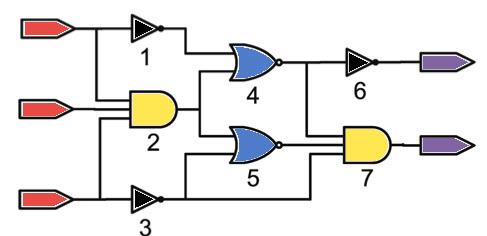
Course Topics
- Unit 1 - Logic system and Gates
- Logic system and Gates
- Boolean algebra
- Boolean algebra - simplification
- Canonical forms
- Karnaugh Map
- Quine MC cluskey method
- Number systems
- Number system conversions
- Binary codes and BCD codes
- Combinational circuits
- Digital arithmetic circuits
- Multiplexer
- Sequential circuits
- Flip flops
- Flip flop conversions
- Shift registers
- Application of shift registers
- Counters
- Unit 2 -A/D and D/A converter
- Analog to Digital converter
- A/D converter types
- Digital to analog converter
- D/A converter types
- Unit 3 - Digital integrated circuits
- Transistor Transistor Logic
- Cmos Gates
- Semiconductor memories
- Types of memories
- RoM and it’s types
- RAM and it’s types
- Unit 4 -PLC
- PLC block diagram
- PLC block diagram - I/O units
- Working and types of PLC
- PLC module
- PLC ladder logic
- USES OF PLC
- BLOCK DIAGRAM OF PLC
- INPUT BLOCK DIAGRAM - PLC
- OUTPUT BLOCK DIAGRAM OF PLC
- CONNECTION OF INPUT TO PLC
- CONNECTION OF OUTPUT TO PLC
- ADVANTAGES AND SIZE OF PLC
- I/O MODULES OF PLC
- I/O CIRCUITS OF PLC
- plc-types of inputs
- PLC-OPERATION
- PLC-PROGRAMMING LANGUAGES
- PLC-TYPES OF PROGRAMMING LANGUAGES
- LADDER LOGIC DIAGRAM FOR LOGIC GATES
- PLC INSTRUCTION
- INPUT,OUTPUT,RELAY,LOGIC INSTRUCTIONS
- PLC-COUNTER INSTRUCTIONS,MATH INSTRUCTIONS
- PLC-DATA COMPARISON & TIMER INSTRUCTIONS
- PLC-JUMP,LABEL AND SEQUENCER INSTRUCTIONS
- PLC-SUBROUTINE INSTRUCTIONS
- PLC-MCR INSTRUCTION
- PLC-COMMUNICATION AND NETWORKS
- PLC-TROUBLESHOOTING
- PLC-SERVICING AND MAINTENANCE
- SCADA-INTRODUCTION
- SCADA-BASICS
- ARCHITECHTURE OF SCADA
- SCADA-HARDWARE ARCHITECHTURE
- SCADA - SOFTWARE ARCHITECHTURE
- WORKING PROCEDURE OF SCADA SYSTEMS
- TYPES AND APPLICATION OF SCADA
- MEASURING DEVICES-INTRODUCTION
- Q-METER - DEFINITION , WORKING PRINCIPLE
- Q-METER - CIRCUIT , MEASUREMENTS AND APPLICATION
- LCD-INTRODUCTION,STRUCTURE AND TYPES
- WORKING OF LCD
- LCD-ADVANTAGE,DISADVANTAGE,APPLICATION
Unit 1 - Logic system and Gates
Introduction
A digital circuit is a circuit where the signal should be one of two discrete levels. Each level is interpreted as one of two different states (for instance, 0 or 1). These circuits built with transistors to make logic gates in order to execute Boolean logic operation. This logic is the base of digital electronics & computer processing. Digital circuits are less vulnerable to degradation in excellence than analog circuits. It is also simpler to execute error detection and rectification with digital signals. To make the routine process of designing these circuits, designers use EDA (electronic design automation) tools, a kind of software that develops the logic in a digital circuit.

A digital circuit is used to alter the waves into pulse waves. It measures a waveform thousand of times every second and stores the data in binary form. For instance, after 12msecs, a signal might be 2.4 volts high & after 14msecs, it might be at 2.6 volts. This circuit changes the volts and times into binary data, and the waves become a series of 1’s and 0’s. When the circuit has to generate sound from a speaker, it produces an o/p signal which is at 2.4 V after 12msec and at 2.6 V after 14msec, similar to the original wave

Email: [email protected]
Copyright VIRTUAL GURU © 2025. All Rights Reserved.
